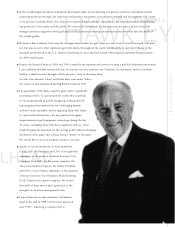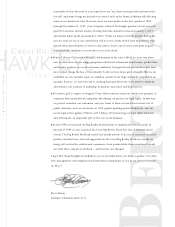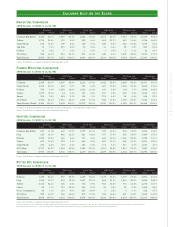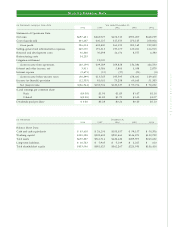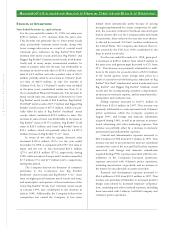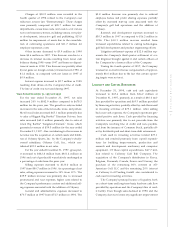Callaway 1998 Annual Report Download - page 15
Download and view the complete annual report
Please find page 15 of the 1998 Callaway annual report below. You can navigate through the pages in the report by either clicking on the pages listed below, or by using the keyword search tool below to find specific information within the annual report.
CALLAWAY GOLF COMPANY
13
products, as well as reduced sales of new products,
given the availability of older products at lower prices.
Historically, the Company has managed such close-
outs so as to avoid any material negative impact on the
Company’s operations, but there can be no assurance
that the Company will always be able to do so.
The Company plans its manufacturing capacity
based upon the forecasted demand for its products.
Actual demand for such products may exceed or be less
than forecasted demand. The Company’s unique prod-
uct designs often require sophisticated manufacturing
techniques, which can limit the Company’s ability to
quickly expand its manufacturing capacity to meet the
full demand for its products. If the Company is unable
to produce sufficient quantities of new products in time
to fulfill actual demand, especially during the
Company’s traditionally busy second and third quarters,
it could limit the Company’s sales and adversely affect its
financial performance. On the other hand, the
Company commits to components and other manufac-
turing inputs for varying periods of time, which can
limit the Company’s ability to quickly react if actual
demand is less than forecast. As in 1998, this could
result in excess inventories and related obsolescence
charges that could adversely affect the Company’s finan-
cial performance.
Product Breakage
The Company supports all of its golf clubs with a limit-
ed two year written warranty. Since the Company does
not rely upon traditional designs in the development of
its golf clubs, its products may be more likely to develop
unanticipated problems than those of many of its com-
petitors which use traditional designs. For example,
clubs have been returned with cracked clubheads, bro-
ken graphite shafts and loose medallions. In addition,
the Company’s Biggest Big Bertha®Drivers, because of
their large clubhead size and extra long, lightweight
graphite shafts, have experienced shaft breakage at a rate
higher than generally experienced with the Company’s
other metal woods, even though these shafts are among
the most expensive to manufacture in the industry.
While any breakage or warranty problems are deemed
significant to the Company, the incidence of clubs
returned as a result of cracked clubheads, broken
graphite shafts, loose medallions and other product
problems to date has not been material in relation to the
volume of Callaway Golf clubs which have been sold.
The Company monitors closely the level and nature of
any product breakage and, where appropriate, seeks to
incorporate design and production changes to assure its
customers of the highest quality available in the market.
Significant increases in the incidence of breakage or
other product problems may adversely affect the
Company’s sales and image with golfers. While the
Company believes that it has sufficient reserves for war-
ranty claims, there can be no assurance that these
reserves will be sufficient if the Company were to expe-
rience an unusually high incidence of breakage or other
product problems.
Credit Risk
The Company primarily sells its products to golf equip-
ment retailers and foreign distributors. The Company
performs ongoing credit evaluations of its customers’
financial condition and generally requires no collateral
from these customers. The Company believes it has ade-
quate reserves for potential credit losses. Historically, the
Company’s bad debt expense has been low. However, the
recent downturn in the retail golf equipment market has
resulted in delinquent or uncollectible accounts for
some of the Company’s significant customers. As a
result, during 1998 the Company increased its reserve
for credit losses. Management does not foresee any sig-
nificant improvement in the golf equipment market
during 1999, and therefore expects this trend to contin-
ue. Accordingly, there can be no assurance that the
Company’s results of operations or cash flows will not be
adversely impacted by the failure of its customers to
meet their obligations to the Company.
Dependence on Certain Vendors and Materials
The Company is dependent on a limited number of
suppliers for its clubheads and shafts. In addition, some
of the Company’s products require specifically devel-
oped manufacturing techniques and processes which
make it difficult to identify and utilize alternative sup-
pliers quickly. The Company believes that suitable club-
heads and shafts could be obtained from other manu-
facturers in the event its regular suppliers are unable to
provide components. However, any significant produc-
tion delay or disruption caused by the inability of cur-
rent suppliers to deliver or the transition to other sup-
pliers could have a material adverse impact on the
Company’s results of operations.
The Company uses United Parcel Service (“UPS”)
for substantially all ground shipments of products to its
domestic customers. The Company is continually
reviewing alternative methods of ground shipping to
supplement its use and reduce its reliance on UPS.
To date, a limited source of alternative vendors have
been identified and adopted by the Company.
Nevertheless, any interruption in UPS services could


